
The Trionychidae are a taxonomic family of a number of turtle genera, commonly known as softshell turtles. The family was erected by Leopold Fitzinger in 1826. Softshells include some of the world's largest freshwater turtles, though many can adapt to living in highly brackish areas. Members of this family occur in Africa, Asia, and North America, with extinct species known from Australia. Most species have traditionally been included in the genus Trionyx, but the vast majority have since been moved to other genera. Among these are the North American Apalone softshells that were placed in Trionyx until 1987.

The alligator snapping turtle is a large species of turtle in the family Chelydridae. The species is native to freshwater habitats in the United States. M. temminckii is one of the heaviest freshwater turtles in the world. It is the largest freshwater species of turtle in North America. It is often associated with, but not closely related to, the common snapping turtle, which is in the genus Chelydra. The specific epithet temminckii is in honor of Dutch zoologist Coenraad Jacob Temminck.

The spotted turtle, the only species of the genus Clemmys, is a small, semi-aquatic turtle that reaches a carapace length of 8–12 cm (3.1–4.7 in) upon adulthood. Their broad, smooth, low dark-colored upper shell, or carapace, ranges in its exact colour from black to a bluish black with a number of tiny yellow round spots. The spotting patterning extends from the head, to the neck and out onto the limbs. Sexually mature males have a concave plastron and a long, thick tail. By contrast, sexually mature females possess a flat plastron and have a tail that is noticeably shorter and thinner than that of mature males. Mature males also have a dark iris and face; females typically have a yellow or orange iris and a similarly coloured face that is distinctly lighter than the males'. Juveniles appear female-like in this regard, and at maturity males begin to develop darker features.

The chicken turtle is a turtle native to the southeastern United States. It is the only extant member of the genus Deirochelys and is a member of the freshwater marsh turtle family Emydidae. The chicken turtle's scientific name refers to its extremely long neck and distinctive net-like pattern on its upper shell. There are three regionally distinct subspecies, which are thought to have evolved when populations became separated during periods of glaciation. These subspecies can be distinguished by their appearance; the western chicken turtle displays dark markings along the seams of its plastron, while the plastron of the Florida subspecies is a bright yellow or orange color. Fossil records show that the chicken turtle has been present in the region for up to five million years.
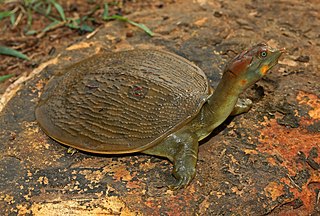
Leith's softshell turtle is a species of turtle in the family Trionychidae. The species is found in peninsular Indian rivers including the Thungabhadra, Ghataprabha, Bhavani, Godavari, Kaveri and Moyar Rivers. The type locality is Pune in India.

The wattle-necked softshell turtle, also commonly known as Steindachner's soft-shelled turtle, is an endangered Asian species of softshell turtle in the family Trionychidae. The species is the only member of the genus Palea.

The Chinese softshell turtle is a species of softshell turtle that is native to China and Taiwan, with records of escapees—some of which have established introduced populations—in a wide range of other Asian countries, as well as Spain, Brazil and Hawaii.

Apalone is a genus of turtles in the family Trionychidae. The three species of Apalone are native to freshwater habitats in North America; they are the only living softshell turtles from the Americas.
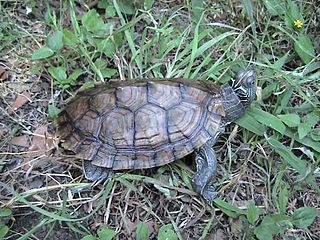
Graptemys is a genus of freshwater turtles containing 14 species, commonly known as map turtles. Graptemys are small to medium-sized turtles that are significantly sexually dimorphic, with females in some species attaining as much as twice the length and ten times the mass as males. Depending on the species, adult males range from 7–16 cm (2.75–6.25 in), adult females 10–29.5 cm (4–11.62 in), and hatchlings 2.5–3.8 cm (1–1.5 in), although some sources indicate female Barbour's map turtles grow to 33 cm (13 in) in length. Most species have a distinctive dark pigmented keel that is often notched or serrated running down the center of the carapace and serrated scutes on the rear margin. The head, neck, and limbs exhibit bold patterns of yellow lines and spots against darker green, olive, or black base colors. The patterns on the head can be important characters in identifying the various species. The common name "map turtle" is derived from the intricate patterns on their shells that are suggestive of topographical maps, although the patterns are more apparent in some species than others, and often become obscure in older specimens. Some species are occasionally called "sawbacks", in reference to the serrated keels on their shell.

The spiny softshell turtle is a species of softshell turtle, one of the largest freshwater turtle species in North America. Both the common name, spiny softshell, and the specific name, spinifera (spine-bearing), refer to the spiny, cone-like projections on the leading edge of the carapace, which are not scutes (scales).

The Texas spiny softshell turtle is a subspecies of the spiny softshell turtle in the family Trionychidae. The subspecies is native to the southwestern United States and adjacent northeastern Mexico.

The Gulf Coast spiny softshell turtle, a subspecies in the Trionychidae family of softshell turtles, is endemic to the south-eastern United States.

The river cooter is a species of freshwater turtle in the family Emydidae. The species is native to the central and eastern United States, but has been introduced into parts of California, Washington, and British Columbia.

The Yangtze giant softshell turtle, also known commonly as the Red River giant softshell turtle, the Shanghai softshell turtle, the speckled softshell turtle, and Swinhoe's softshell turtle, is an extremely rare species of turtle in the family Trionychidae. It may be the largest living freshwater turtle in the world. The species is native to eastern and southern China and northern Vietnam. With a known population of only three individuals, and with the last females dying out, this species is considered functionally extinct.
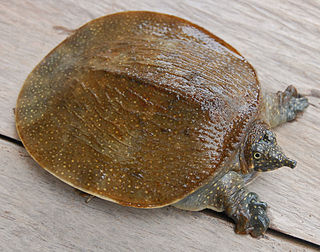
The Asiatic softshell turtle or black-rayed softshell turtle is a species of softshell turtle in the Trionychidae family. Despite its name, it is not the only softshell turtle in Asia.

The black-knobbed map turtle, formerly known as the black-knobbed sawback, is a small to medium-sized aquatic turtle with light gray skin. Some of the most distinguishing characteristics of the black-knobbed map turtle, and the Graptemys genus, are the protruding "spikes" on the turtle's carapace. This species inhabits mainly the fall lines of rivers in the Mobile Bay drainage, in Alabama and Mississippi.

The northern map turtle, also known as the common map turtle, is an aquatic turtle in the family Emydidae. It is endemic to North America.
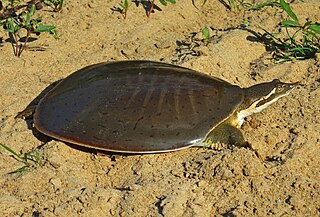
The smooth softshell turtle is a species of softshell turtle of the family Trionychidae. This freshwater turtle is endemic to the United States where it inhabits the Mississippi River system and other river basins emptying into the Gulf of Mexico.

The Euphrates softshell turtle, also known as the Mesopotamian softshell turtle, is a species of softshell turtle in the family Trionychidae. It is found throughout much of the Euphrates–Tigris river basin in Iraq, Syria, Turkey and Khūzestān Province of Iran. Historically it has also been reported from Israel, but this likely involves confusion with the very similar Trionyx triunguis.
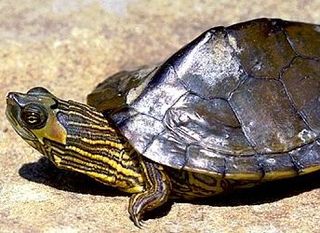
The Alabama map turtle is a species of emydid turtle endemic to the southern United States. Differentiation from other turtle species includes a black stripe running down the center of its back with knobs extruding from it, but these projections wear down with age. T.H. Bean and L. Kumlen first collected the Alabama map turtle in July 1876 from a lake near Montgomery, Alabama. Type locality for this species is Montgomery County, Alabama. Baur described and named the Alabama map turtle in 1893. The genus Graptemys includes nine species of mostly aquatic turtles.

























